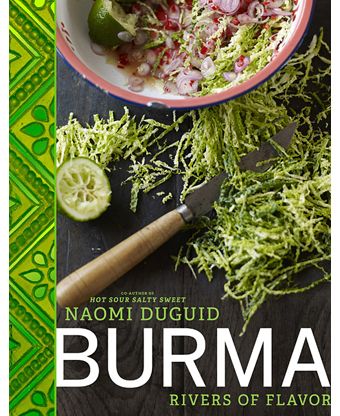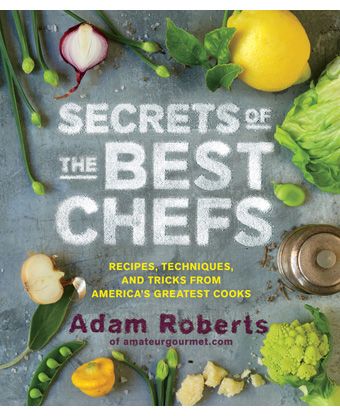I received my Piglet books weeks apart from one another, so I had a good deal of time to mull over Adam Roberts' collection before I even laid eyes on Burma. My first thought upon scanning Secrets was that the design is a bit bland -- the layouts, the photos, the text, etc. Visuals are important to me. If I'm not intrigued or inspired by what I find as I flip through the pages of a cookbook, it's difficult for me to be motivated to keep coming back for more, particularly when it comes to being enticed by a recipe. When I'm about to dedicate my time (and my stomach) to cooking something, having a sense of what I'm going for makes a significant difference, as does whether or not the dish looks particularly appetizing. Granted, I make a lot of meals for myself that aren't especially pretty but that taste delightful, so it's not necessarily that I am prejudiced against ugly food. However, if I'm relying on a cookbook to curate a collection of yummy things for me, I like to at least be seduced by its pages. Truth be told, none of the dishes presented in Secrets looked unappetizing on first glance -- but a slew of white pages full of text seemed rather uninspired.
Of course, there's presumably a reason that Adam Roberts wrote his book like this. He does an excellent job of spelling out every recipe -- of walking the amateur (or the skilled) chef through each step, giving down-to-earth tips and anecdotes along the way. He spends time sharing some background about each chef featured, revealing their personalities not only through photos and their chosen recipes, but also through the history of their restaurants, their style, and the way they handle a kitchen. These certainly aren't glamour shots; rather, each chef is photographed on a normal day at the stove. In fact, the book itself reminds me a bit of boring chef's whites: the layout reflects the plain, standard uniform of the chefs themselves, so that the secrets shared might stand on their own. Rather than relying on the finesse of fancy food styling or sexy design, Roberts falls back on the strength of the recipes themselves. Based on the blueberry crostada I made (twice!) -- which may well involve the best pastry crust I have ever tasted -- Roberts certainly did his homework to make sure the directions rang true for each dish.
In contrast to the lackluster visual appeal of Secrets, Naomi Duguid's collection of recipes and traditional flavors from Burma contains an explosion of colors, textures, and almost sounds that seem to fly off the page. Color isn't always necessary for catching the home chef's eye, but in this case, the richness and vibrancy of each page and each dish calls out to eaters and cooks alike to quicken to the kitchen and to get experimenting. Duguid not only does an excellent job of rendering the dishes she's sharing photographically, but she also spends a good deal of time putting them in cultural context by providing the history of the food or the specific region that food comes from. I was immediately drawn in and motivated to test some of the dishes she outlines.
I quickly discovered that casual cooks who are faint of heart should beware, however. This book may not be for the infrequent gourmet who wants to venture into Southeast Asian food delicately -- nearly every dish requires some special cache of ingredients that you'd better plan to track down, or be ready to prepare yourself ahead of time. For instance, any number of recipes require fermented soybean paste, ground soybean disks, tapioca flour, and a variety of sauces that can be made at home, but which require some forethought. However, if you're dedicated to the pursuit of learning to cook this way on a consistent basis, Duguid is careful to outline how one can easily begin stocking the cupboard with these essentials. For someone (like myself) who is not used to cooking with these kinds of flavors and ingredients, it was a bit overwhelming to flip through and discover that I had very few of the called-for ingredients on hand. However, the suggested payoff (shown on two-page spreads of brightly seasoned foods including an abundance of rice, salads, sauces on the side) for an initial bit of trouble seems to quiet the preceding hesitation. Duguid invites readers to engage in not only a culinary lesson, but also in an investigation of the everyday life and customs of the Burmese people, which proves to be quite rewarding if you can make it through the somewhat foreign combinations and techniques. The dish I settled on making (Golden Egg Curry) ended up being quite simple, straightforward, and satisfying, and provided a good alternative to some of the other mundane egg dishes I often find myself making.
All in all, I found that my fascination lay more with Burma: Rivers of Flavor than with Roberts' anthology of chef's secrets from around the nation. While I truly enjoyed Roberts' fresh take and behind-the-scenes look at well-renowned and recognizable chefs, in all honesty, I rarely have the gumption to approach dishes like Bone Marrow and Escargot, and it takes more than a friendly intro to inspire me to do so (though to be fair, there is a spectrum of difficulty represented in the book). On the flipside, although the recipes in Burma also present me with the challenge of unfamiliarity of flavor and a bit of fear of the unknown, Duguid's thoughtfulness in making these recipes seem approachable, knowable, and tantalizing to the taste buds has ultimately won me over.



42 Comments
To those who are concerned about getting ingridients, there are several websites you can order Burmese food from.
any recommendations ?
I know people usually like Mohinga, the fish soup with noodles and also the tea salad is something different. I would recommend fish head soup with bamboo shoots.
---in the reject pile.